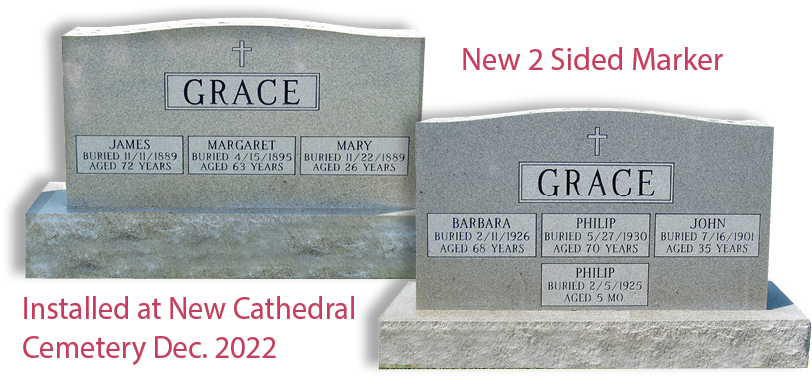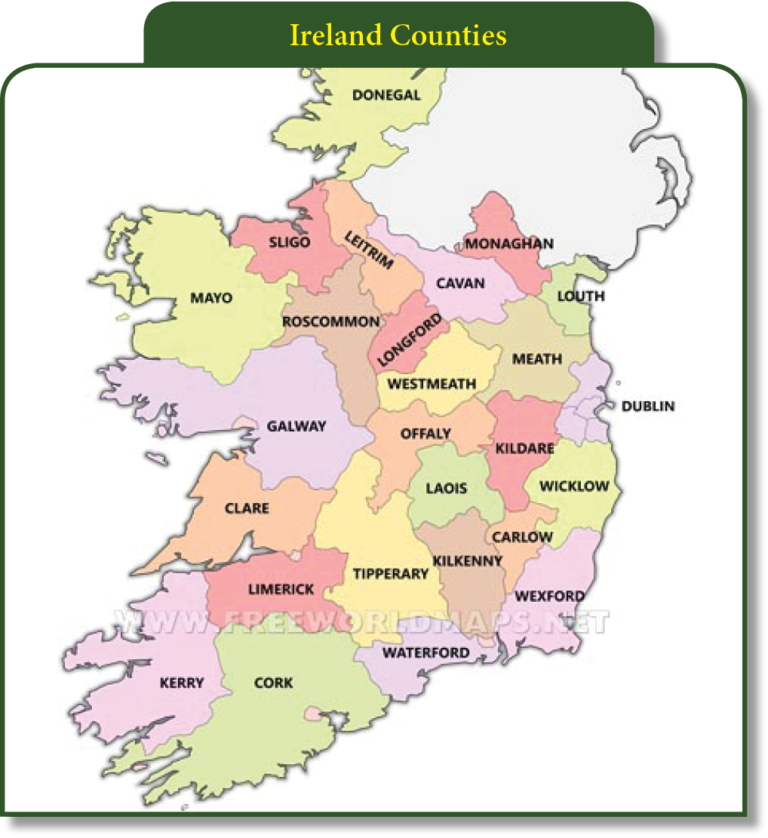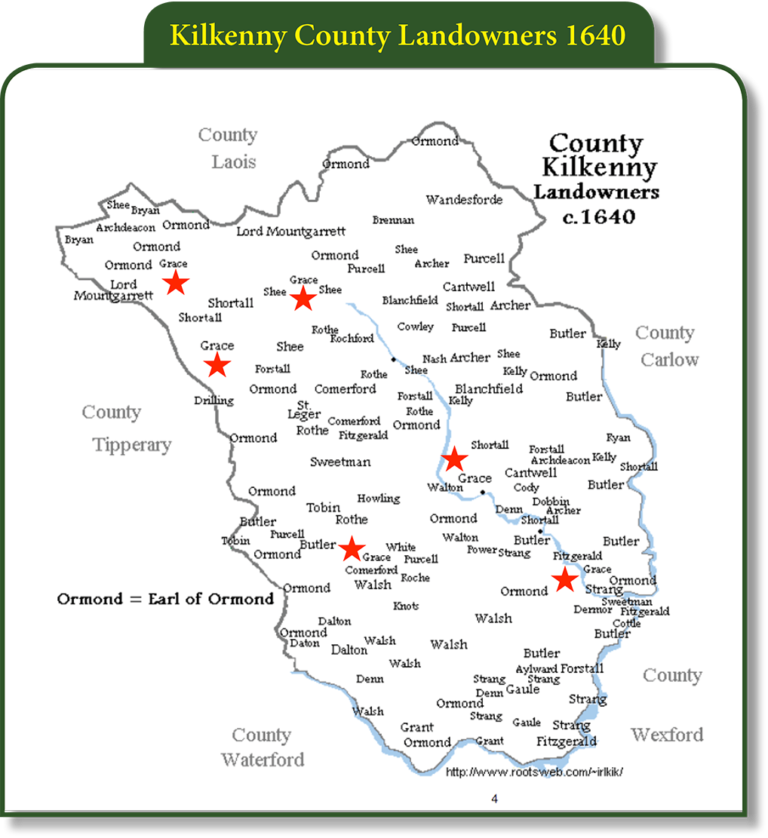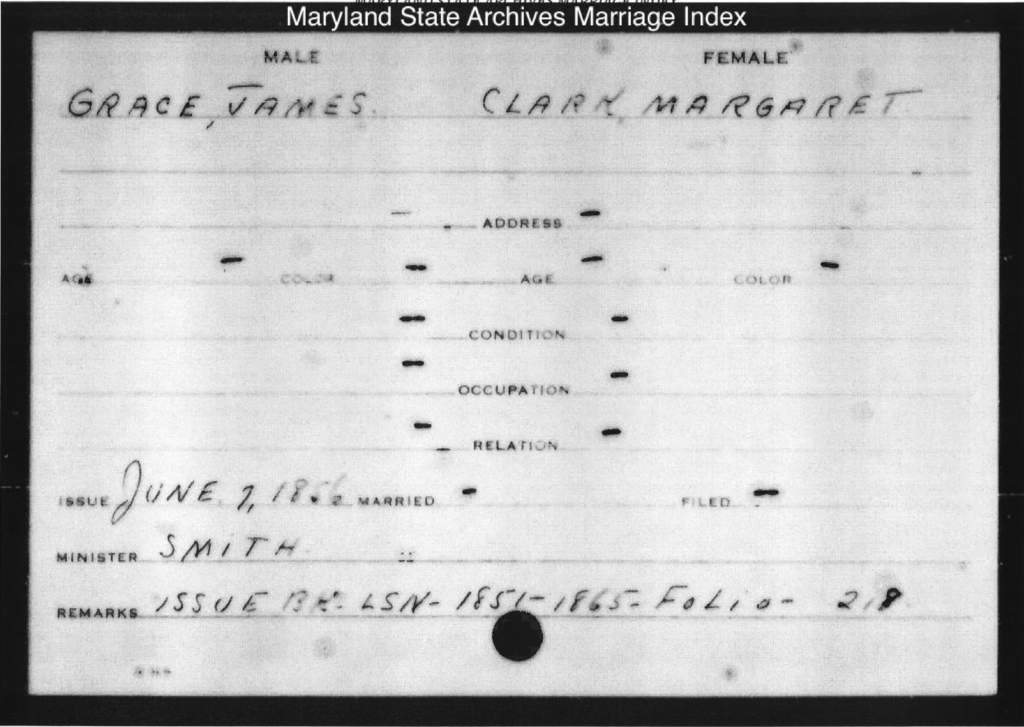Family History Book ~ James Grace
The Beginning
At the time of this writing, it had only been a few years since we learned that our great-great grandparents, James and Margaret Grace, who came to this land in the latter part of the 19th century did not have a proper grave marker. There were seven of our ancestors interred in New Cathedral Cemetery-4300 Old Frederick Road, Baltimore, MD-in Section S, Lot 190, Graves 1-6 from 1889-1930 with only a single-obscured by growth-ground marker that just read “James Grace”.
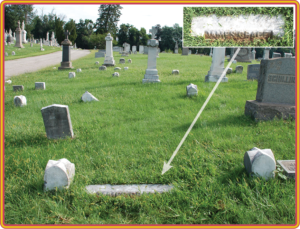 If you are one of the 48 cousins reading this, then you are 5th generation in this country as descendants of James and Margaret Grace. They are your great-great grandparents. Being one of the 48 cousins, Madalen McKenna-Kight spearheaded a joint effort to raise funds for a decent marker for our ancestors. With exceptional organizational skills and corresponding via phone, emails and texts with the rest of cousins, relatives and extended family as well as New Cathedral cemetery, she raised funds for a beautiful marker with all the interred being identified.
If you are one of the 48 cousins reading this, then you are 5th generation in this country as descendants of James and Margaret Grace. They are your great-great grandparents. Being one of the 48 cousins, Madalen McKenna-Kight spearheaded a joint effort to raise funds for a decent marker for our ancestors. With exceptional organizational skills and corresponding via phone, emails and texts with the rest of cousins, relatives and extended family as well as New Cathedral cemetery, she raised funds for a beautiful marker with all the interred being identified.
After an effort of more than two years, which was hampered by the covid Pandemic of 2020-2023, the marker was finally installed at the end of 2022. The culmination of this venture was a blessing of the graves ceremony that Madalen orchestrated. Mass was celebrated at St. Joseph’s Monastery-3801 Old Frederick Road, Baltimore, MD-just prior to the event. The blessing of the graves was officiated by Father Michael Murphy and held at the grave site at noon on April 30, 2023.
A commemorative 2 page handout was created for the occasion. For those who were unable to attend, the information on that hand out is below or you can follow the link from the flyer.
 Not all who contributed were able to attend, but more than 30 family members were present. It was a united, respectful, beautiful and memorable event. I believe Bill List, spouse of Jeanette Mckenna-List, posted a video of the event on YouTube and Madalen also shared a similar video on the Grace family facebook pages
Not all who contributed were able to attend, but more than 30 family members were present. It was a united, respectful, beautiful and memorable event. I believe Bill List, spouse of Jeanette Mckenna-List, posted a video of the event on YouTube and Madalen also shared a similar video on the Grace family facebook pages
“Our Graced Family” and “ Full of Grace”.
Those interred at the site are:
James Grace 1820-1889
Margaret Clark-Grace (James’ Wife) 1823-1895
Philip J. Grace Sr. (James & Margaret’s Son) 1858-1930
Barbara Ellinger-Grace (Philip’s wife) 1857-1926
Mary A. Grace (James & Margaret’s Daughter) 1862-1889
John Grace (James & Margaret’s Son) 1865-1901
Philip J. Grace III (James & Margaret’s Great-Grandchild) 1924-1925
James Grace 1820-1889 and His Descendants
From public records, we know that James immigrated to the U.S. from Ireland about 1850. Records from the St. Alphonsus marriage records indicate that he married Margaret Clark on June 14, 1856. His parents were Philip Grace and Mary Walsh. Margaret’s parents were Johannis Clark and Elise Linn. James’ origin indicated that he was from “Kilkenny, Ireland” and Margaret from “Sligo, Ireland”.
James was Naturalized in Baltimore County, Maryland on Monday, November 1, 1875 (C.C. NAT. Folio 406). His sponsors/witnesses were Halbert Hoffman and George Washington Wade. They were also from District 13-Baltimore County and lived in the same vicinity of our ancestors on Washington Boulevard-referred to as Washington Road in those days.
James was baptized on July 6, 1823, in Ashtown, Kilkenny, Ireland in the Diocese of Ossory. Ashtown in Kilkenny County is not to be confused with Ashtown in Dublin County. The Ashtown in Dublin is considered an actual town. The Ashtown in Kilkenny is considered a townland. A townland is not an actual town. It is more of an area within a town and is usually associated with a parish. Townlands were and are still used as geographic descriptions of a given area, and they are typically 100-500 acres in size with some being much larger and some much smaller.
We know from the Irish Baptismal records of Owning and Templeorum, Kilkenny, Ireland in the Diocese of Ossory that James had at least 5 siblings. From what records can be found in that diocese, he was the fifth of six children of Philip Grace and Mary Walsh. He had two older sisters, Honor Grace who was baptized June 24, 1811 and Mary Grace who was baptized June 4, 1817. He had two older brothers, Edward Grace who was baptized June 27, 1808 and Martin Grace who was baptized November 10, 1820 and a younger brother, John who was baptized June 29, 1826. There is a significant gap between the births of Honor and Mary so there may have been other children, but these are the only records that could be located. All the baptismal records indicate they were born in Ashtown, Kilkenny, Ireland. There is more information about Ashtown and James’ siblings in the link at the bottom of the page.
A Little about Edward Grace
The 1860 U.S. Federal Census finds our great-great-grandfather, James Grace and his wife Margaret in District 13, Baltimore County. He appears to have a neighboring relative with the name Edward Grace. From that record, Edward appears to be about 10 years older than James. It has long been assumed that Edward was either a brother or cousin to our James. From my own recent DNA matches to Edward’s decendants, it would appear that he was his brother.
It is believed that at age 38, Edward Grace arrived on the Ship Americana on April 17, 1848 with an occupation listed as Waterman. He married Catherine Dougherty in St. Peter the Apostle Roman Catholic Church located at the northwest corner of Hollins and South Poppleton Streets, Baltimore, Maryland on July 7, 1857. Their first child, Mary was born March 20, 1860 and baptized April 1, 1860 in St. Agnes Church located at 5422 Old Frederick Rd, Baltimore, Maryland. There is more about their daughter, Mary, in a moment.
I describe the 1870 census records for the Edward Grace household as indistinct because Edward had disappeared, but it appeared he and Catherine had more children. Mary is still listed, but there is now a Kitty age 8 which I assume is a nickname for Katherine, an Annie age 7 and a Henry age 2. It is worth noting that when you track people and families in the census records from decade to decade, you may find that their ages can be woefully off and sometimes vary by several years.
UPDATE: From more recent findings such as the newpaper legal notices published in the Baltimore County Union-Towsontown, Maryland newspaper (a weekly publication) on December 5th and 12th, 1868 (Library of Congress-newspapers) and the estate settlement and inventory for Edward Grace in the Maryland State Archives dated December 7, 1868 and February 1, 1869 respectively; it would appear that Edward died in late November or very early December 1868.
It is my carefully considered opinion that these entries are correct and that the cenus-taker recorded the names of the children forgetting that they were supposed to be listed from oldest to youngest. Subsequently, the census-taker just listed the ages next to each child in descending order. It is also possible that whomever gave the names did not give them in descending order when first asked; but then did give the ages in descending order when asked for their ages. I found this to be true in other families that were enumerated in 1870, in District 13 where the names were correct, but the ages were scrambled and did not align with the correct child. Even if the mistake was realized at that time, they never wasted paper. They were more interested in head count than accuracy.
Moving on, the 1880 census finds Edward’s wife Catherine age 40, Katie age 14 and Annie age 12. Mary had married and Henry likely died because they are now missing from the household.
I did find baptismal records for Katie. She was baptized as Mary Catherine Grace on February 18, 1866, in St. Peter the Apostle Roman Catholic Church, Baltimore City, Maryland. Her age aligns with the 1880 census record. I also found the baptismal record for another child, Sarah Grace. She was baptized on December 7, 1863, in St. Peter the Apostle Roman Catholic Church, Baltimore City, Maryland. Sarah likely also had a short life because she never appeared in the 1870 census.
Life in the 19th and 20th centuries was not easy, but this was especially true for children. In the 1800s, up to 30% of children died before their first birthday, and 43% did not survive past their fifth birthday. If the child lived to ten, they still only had a 60% chance of surviving to adulthood.
https://www.greenecountyohio.gov/
The child mortality rate in the United States, for children under the age of five, was 462.9 deaths per thousand births in 1800. This means that for every thousand babies born in 1800, over 46 percent did not make it to their fifth birthday. Contributing causes in the 1870s were the result of the fourth cholera pandemic, smallpox outbreaks and yellow fever.
https://www.statista.com/statistics/1041693/united-states-all-time-child-mortality-rate/
If you’re reading this, know that your ancestors were the fortunate ones.
According to census records from 1860-1880, there were only a handful of Graces living in District 13, Baltimore County. They consisted of James Grace and Edward Grace and their families. Although their exact locations are still unknown, we know they lived in the vicinity of Casper Eichelman. Casper came to this country from Germany in 1838 and was one of the original landowners in District 13. The address of the Eichelman farm was 3406 Washington Boulevard, Baltimore County, Maryland.
John Eichelman Sr. was the youngest of Casper’s 5 known children.
At the age of 20-21, Philip Grace, son of James, appears in the 1880 census living with the Eichelmans with an occupation listed as a servant. This likely meant he was a worker on the farm or at the tomato cannery that the Eichelmans ran at one time. Still, I thought it a little strange until I began to suspect that Mary Eichelman who married John Eichelman Sr. was the daughter of Edward Grace.
I got this notion when I noticed that Edward’s daughter, Mary who would have been about 19-20, disappeared from the Edward Grace household in the 1880 census. She had either died or married so I began to wonder if Mary Eichelman who married John Eichelman Sr. was Edward’s daughter. I used an Excel spreadsheet to sort and filter the given name Mary who would have been about 20 years of age in the 1880 census. There were dozens, but there were only 3 in that age range in District 13. Of the 3, only 2 were listed as caucasian. Of those 2, only one had parents born in Ireland so I had a good hunch that this was Edward’s daughter, Mary.
It never occurred to me prior because John Eichelman Sr.’s wife’s maiden name was Scharf. While reading some background history on the Boulevard written by James Nicholas Heile, I noted that he referred to Annie Eichelman as the half-sister of the rest of the Eichelmans. There were 8 known children of John Eichelman Sr. and his wife, Mary. This meant that John Eichelman Sr. had married twice to a woman with the given name Mary. Indeed, subsequent research revealed that his first wife was Edward Grace’s daughter, Mary.
I can find no record of Mary’s death. I did find that John Eichelman Sr. and Mary Grace-Eichelman had a child born on October 21, 1880, then baptized on October 24, 1880 at St. Joseph’s Monastery 3801 Old Frederick Rd, Baltimore, Maryland named Mary Ann (Annie) Eichelman. This means that they married in the late 1870s or early in the year 1880. There isn’t an 1890 census to refer to so when you look at the 1900 census, you’ll find that John Eichelman Sr. and his wife, Mary Scharf-Eichelman had 7 more children. There is also a 5-year gap between the birth of Annie and the birth of the next child which implies that Mary Grace Eichelman died somewhere between October 1880 and probably the end of 1884.
UPDATE: In a book titled “The Eichelman Odyssey-Volume I” by Yvonne Schaeffer and published in 2012, it is written that Mary died giving birth to their (John Eichelman Sr. and Mary Grace) second child, Caspar. Additionally, it is noted in the Marriage record of John Eichelman Sr. and Mary Scharf on April 29, 1884 in Fourteen Holy Martrys Catholic Church in Baltimore City, Maryland that John is a widower.
All of this helped me understand why Philip Grace Sr., son of James appeared living with the Eichelmans in 1880. It’s a fairly safe assumption that Edward Grace and James Grace were, at least, cousins but most probably brothers. My own recent DNA matches leading back to Edward Grace indicate that they were brothers. There is more detail about that in a link at the bottom of this page concerning James Grace and his siblings from Ashtown, Kilkenny, Ireland. Not only were the Graces and Eichelmans neighbors, but Philip was either first or second cousin to Mary Grace because he was the son of James and Mary was the daughter of Edward.
Also worth noting, this discovery was realized as the first of several Grace-Eichelman unions. There is another link at the bottom of this page with some amusing and amazing Grace-Eichelman intertwinements in the years past.
Philip J. Grace Sr. 1858-1930 and His Descendants
Philip J. Grace was the only surviving offspring of James and Margaret Grace to marry and have children. He married a women of German descent, Barbara Ellinger who was also of the Lansdowne-Halethorpe area in 1883. Philip was a machinist as a youth and later spent many years with the Halethorpe Fire Department. Their home for many years was on the east side of Washington Boulevard about a quarter mile north of what we know today as Lansdowne Road. The home has long since been taken down, but part of the mosaic brick retaining wall in the front is still visible today. As of this writing, you can see it clearly in the winter months (when it’s not covered by summer growth) if you stand on the corner of Wilson Avenue and Washington Boulevard facing east.
Philip and Barbara raised seven children on the boulevard:
• George Thomas Grace 1885-1940
• Clarence Edward Grace 1887-1951
• Mary Cecelia Grace-Eichelman 1889-1952
• William James Grace 1891-1946
• John Joseph Grace 1894-1958
• Margaret Grace-Steinwedel 1896-1954
• Philip John Grace Jr. 1899-1960
Philip J. Grace Jr. 1899-1960 and His Descendants
Philip John Grace Jr. married a woman named Della Houck in 1920. They lived about a half mile south on the boulevard from the original Philip John Grace Sr. and Barbara Ellinger home and had 6 children together:
• Mary Cecelia Grace-Cox (Babe) 1921-2004
• Margaret D. Grace-Dembrowicz (Sis)1922-2009
• Philip John Grace III 1924-1925
• Emma B. Grace-Schmelyun (Dot)1926-1998
• Elva Marie Grace-Wallace 1929-1999
• Philip Anthony Grace Sr. 1934-2011
Blessing of the Graves ~ April 30, 2023
Video Courtesy of William List
Some Ireland Geography
Republic of Ireland
The County Kilkenny Ireland Genealogy website, “Summary Histories for selected County Kilkenny Surnames” has much information of various Grace families throughout history from Raymond le Gros, or le Gras, one of the three outstanding figures of the Anglo-Norman invasion in the 12th century to 1690 and beyond. The territory in which the ‘la Gras’ family acquired shortly after the Anglo-Norman invasion was in what is today County Kilkenny (it was called Grace’s country). 1
Our Grace family, may be descended from the Cambro-Norman, Raymond le Gros, who acquired territory in Kilkenny in the late 12th century or from any of the Grace’s described. It is difficult to trace with any accuracy as many Grace family histories are written.
Kilkenny Tartan
There are very few Irish family tartans, unlike Scotland where there are hundreds. Most people of Irish heritage wear the tartan of the county or province where their families lived. 2
1. http://www.rootsweb.ancestry.com/~irlkik/ksurnam2.htm
2. https://irishtraditionsonline.com/product_cat/irish-tartans/——–
Note the prevalence of the Grace name as landowners in the map above. Also note the name Walsh which appears prevalent in the southern area of the county. This is significant because this is where Ashtown, mentioned earlier is located. There is more information about Ashtown in the like below.
A Little More About James and Margaret
and Their Irish Homeland
Persecution in Ireland reigned from the time of Cromwell in 1651. The lands and possessions of the native Irish Catholics were confiscated by their British conquerors who imprisoned, tortured, and exiled to North America or to Australia the Irish people.
For more than two hundred years, the English levied exorbitant taxes which reduced the Irish to barely enough on which to exist. Many demanded unreasonable rents from the former farmers who might be allowed to live on a few acres of their subdivided property yet could be evicted at the will of the landlord. Payment for tending the crops would be a portion of the crop of potatoes for their family. There was little if any incentive to improve conditions as any improvements were considered to be the property of the middleman or landowner. Depression after the Napoleonic Wars, partial famines in 1817 and 1822, unjust and unreasonable rents, tithes, and leases, unemployment from the advent of the machine age from hand labor . . . all these caused increased distress.
The beautiful Emerald Isle of Ireland was an agricultural nation but the people were among the western world’s poorest. They married young, had large families with high infant mortality, and male life expectancy was usually no more than forty years. According to a 1835 British survey, half of the rural families lived in single room cabins with dirt floors, slept on straw on the bare ground, and shared their living space with their pig and poultry if they had any. Multiple families dwelt together in dire circumstances . This set the scene for hatred of the British. Those who foresaw the future left for America or Canada long before the major potato famine of 1845-51. 4
4. https://www.stcolumban-irish.com/
 From the earliest of recorded times right through the 1800’s, many of the Irish were bought, sold or traded as so called slaves. Many became indentured servants. Indentured servitude differed from slavery in that it was a form of debt bondage, meaning it was an agreed upon term of unpaid labor that usually paid the costs of the servant’s debt and/or immigration to America. Indentured servants were not paid wages but they were generally housed, clothed, and fed. Most importantly, servitude wasn’t hereditary. Children of indentured servants were born free; slaves’ children were the property of their owners.
From the earliest of recorded times right through the 1800’s, many of the Irish were bought, sold or traded as so called slaves. Many became indentured servants. Indentured servitude differed from slavery in that it was a form of debt bondage, meaning it was an agreed upon term of unpaid labor that usually paid the costs of the servant’s debt and/or immigration to America. Indentured servants were not paid wages but they were generally housed, clothed, and fed. Most importantly, servitude wasn’t hereditary. Children of indentured servants were born free; slaves’ children were the property of their owners.
https://www.history.com/news/5-myths-about-slavery
Indentured servitude continued until the early 20th century though at a vastly reduced number than in the century before.
https://limerickslife.com/indentured-servitude/
As of this writing, we have no documentation to indicate that James Grace or Margaret Clark were part of this servitude; however, their ancestors may well have been.
The records for James Grace and Margaret Clark are few. As mentioned earlier, we know from St. Alphonsus’ Church records here in Baltimore, MD that they were married June 14, 1856. In these records, James’ parents are recorded as Philip Grace and Mary Walsh. Margaret’s parents were Johannis Clark and Elise Lynn.
James’ origin indicated that he was from “Kilkenny, Ireland” and Margaret’s was “Sligo, Ireland”. Sligo is far north of Kilkenny so it is unlikely that James and Margaret would have met in Ireland. “Jakobus” as noted on the marriage record was a common reference for the name “James”.
While there are at least three accounts in a calculated time period of a “James Grace” that immigrated to the U.S. from Ireland at about the age of 30, what we do know is that it was in or about 1850.
This was in the midst of the potato famine. The cause of the famine was a potato blight that infected Europe during the 1840’s.
From the late 17th century to the mid 19th century, there were masses of Irish who left their homeland in the midst of religious oppression and economic anxiety for a better life. None of these exoduses was as large as the one whose catalyst was the Great Potato Famine that lasted from 1845-1852.
At that time, the tenant farmers of Ireland were ruled as a colony of Great Britain and they relied heavily on the potato as a source of food. The infestation had a devastating impact on Ireland and its population. By the end of 1852, the Potato Famine had caused the death of roughly one million Irish from starvation and related causes, with at least another one-two million forced to leave their homeland as refugees.
Some Political Back-Story about Ireland to Consider
With the ratification of the Act for the Union of Great Britain and Ireland in 1801, Ireland was effectively governed as a colony of Great Britain until the Irish War of Independence ended in 1921. Together, the combined nations were known as the United Kingdom of Great Britain and Ireland.
As such, the British government appointed Ireland’s executive heads of state, known respectively as the Lord Lieutenant and the Chief Secretary of Ireland, although residents of the Emerald Isle could elect representation to the British Parliament in London.
In all, Ireland sent more than 100 representatives to the House of Commons – the lower house of Parliament – and 28 “peers” (titled landowners) to the House of Lords, or the upper house.
Still, it’s important to note that the bulk of these elected representatives were landowners of British origin and/or their sons. In addition, any Irish who practiced Catholicism which was the majority of Ireland’s native population were initially prohibited from owning or leasing land, voting or holding elected office under the so-called Penal Laws.
Although the Penal Laws were largely repealed by 1829, their impact on Ireland’s society and governance was still being felt at the time of the Potato Famine’s onset. English and Anglo-Irish families owned most of the land, and most Irish Catholics were relegated to work as tenant farmers forced to pay rent to the landowners.
Ironically, less than 100 years before the Famine’s onset, the potato was introduced to Ireland by British landed gentry. Landed gentry were a British social class of landowners who could live entirely from rental income, or at least had a country estate. Despite the fact  only one variety of the potato was grown in the country, It was called “Irish Lumper” it quickly became a staple food of the poor, particularly during cold winter months. Children depicted here are digging through a harvested potato field looking for leftovers.
only one variety of the potato was grown in the country, It was called “Irish Lumper” it quickly became a staple food of the poor, particularly during cold winter months. Children depicted here are digging through a harvested potato field looking for leftovers.
Given the time frame of the Potato Famine in Ireland and the debut of James Grace and Margaret Clark in the 1860 U.S. Federal Census, District 13, it is believed that they were part of the Great Potato Famine Exodus. As mentioned earlier, the potato blight was disastrous to the Irish people.
Prosperity, freedom and a better life is what these Irish immigrants to America and the colonies hoped and prayed for, but that is not what they found here. Lack of employment due to discrimination, hatred and resentment toward the Irish were ubiquitous.
Few have not heard of the employment signage that included “No Irish Need Apply”. during this influx of Irish to the Eastern cities and colonies. In many ways, it is comprehensible. They weren’t disliked simply because they were Irish. It was due to the fact that the Irish would take any job they could obtain even if they wages were incredibly low. They too needed to feed themselves and their families. Because they would work for low wages, this put the employed American born citizen in an untenable position. If they demanded higher wages, they would be reminded by the employer that they could be replaced with an Irishman.
We’ve no way of knowing how much of this hardship that James and Margaret endured. We do know that they appeared in the U.S. 1860 Federal Census in District 13 and a following entry (likely a neighbor) in that census carried the names of Edward and Catherine Grace with an infant child named Mary. Because Edward is listed as age 50 and James as 40, the supposition is that Edward was either a brother, cousin or possibly even an uncle given the large Irish families. It is my guess that James followed Edward here.
As mentioned, in censuses subsequent to 1860, Edward falls off and the entries for Catherine are indistinct. There is, however, an obituary in the Baltimore Sun dated November 11, 1911 for a Catherine Grace which indicated she was the widow of Edward Grace and that she died November 7th at her home “Washington Grove” which I believe was supposed to be Washington Road, as it was referred to in those days. Her funeral took place at St, Clement’s Church and she was interred in St. Peter’s Cemetery.
There are many records from St. Peter the Apostle Roman Catholic Church in Baltimore, Maryland that are available online including baptisms, marriages and confirmations. Sadly, the records for internments, which must be vast, are still only available at the Maryland State Archives in Annapolis. I feel confident that Edward Grace who must have died shortly before 1870 is also interred there, but that remains to be explored.
We know that Philip John Grace Sr. was the only offspring of James and Margaret that wed and had a family. That’s why we are here. Yet, Edward Grace and Catherine Dougherty’s descendants remain to be explored when more information becomes available.
We know that their first born, Mary, likely died sometime after giving birth to her first born, Annie Eichelman. To my knowledge, Annie was a spinster and never married. Of Edward and Catherine’s other children, Henry and Sarah appear to be victims of the child mortality rate in the 1870s. Mary Catherine and Annie are still to be investigated. As of this writing, I have a hunch that Edward and Catherine’s’ Annie was the Anna Grace who married William Stritch. The Stritch family lived about two doors down from what we know as the house on the Boulevard that our grandparents owned and many of our parents grew up in. With the Eichelman farmhouse just a stone’s throw away and knowing that Edward and Catherine lived very close by, it is a reasonable suspicion.
In conclusion for now, there may be another line of Graces out there with whom we have not yet established a blood connection.
